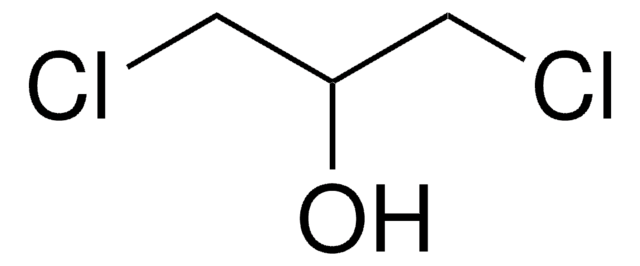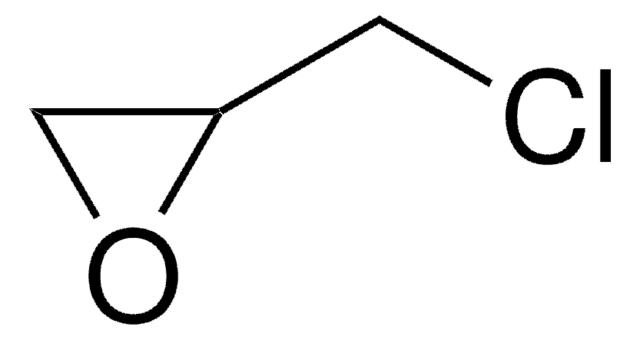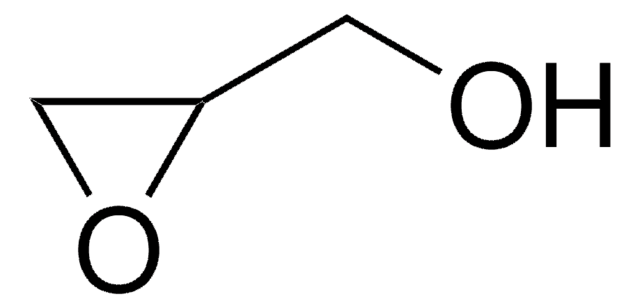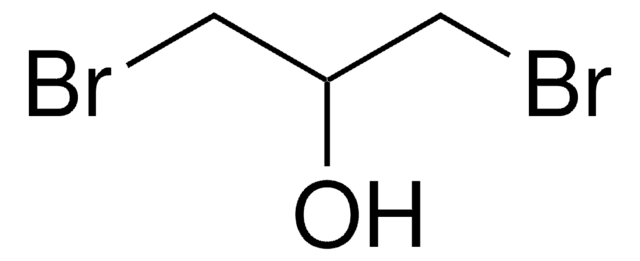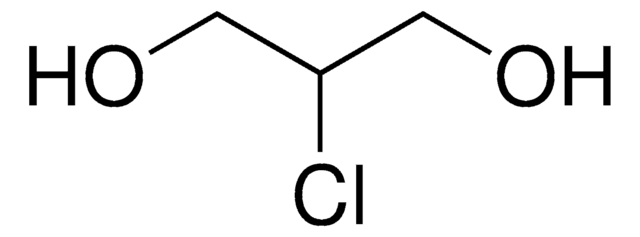推荐产品
质量水平
方案
≥97.0% (GC)
密度
1.360 g/mL at 20 °C (lit.)
官能团
chloro
hydroxyl
SMILES字符串
OCC(Cl)CCl
InChI
1S/C3H6Cl2O/c4-1-3(5)2-6/h3,6H,1-2H2
InChI key
ZXCYIJGIGSDJQQ-UHFFFAOYSA-N
一般描述
2,3-Dichloro-1-propanol belongs to the group of chloropropanols. Inhibitory effects of 2,3-dichloro-1-propanol on T cell both in vivo and in vitro is reported. Improved enantioselective resolution of (R,S)-2,3-dichloro-1-propanol to (S)-2, 3-dichloro-1-propanol by whole cells of a recombinant Escherichia coli in n-heptane-aqueous biphasic system is reported.
应用
2,3-Dichloro-1-propanol may be employed as carbon and energy supplement for the growth of Pseudomonas putida strain (MC4).
警示用语:
Danger
危险声明
危险分类
Acute Tox. 2 Dermal - Acute Tox. 3 Oral - Eye Irrit. 2
储存分类代码
6.1A - Combustible acute toxic Cat. 1 and 2 / very toxic hazardous materials
WGK
WGK 3
闪点(°F)
199.4 °F
闪点(°C)
93 °C
个人防护装备
Eyeshields, Faceshields, Gloves, type ABEK (EN14387) respirator filter
K Imazu et al.
Journal of UOEH, 14(1), 73-76 (1992-03-01)
We investigated the toxicity of dichloropropanols (DCPs) in hematological findings and serum chemistry. The solutions of two isomers of DCPs, 1,3-dichloro-2-propanol (DC2P) and 2,3-dichloro-1-propanol (DC1P) were dissolved in saline at the concentration of 100 mg/ml, and 0.1 ml of each
Yoshiki Kuroda et al.
Journal of UOEH, 24(3), 271-280 (2002-09-19)
A rare outbreak of acute hepatic damage in workers exposed to dichloropropanols was reported in 1992. As there are no detailed reports of dichloropropanols (DCPs) toxicity and its mechanism, we reviewed the toxicity of dichloropropanols using our results. 1) A
Ijaz Gul et al.
Biotechnology and applied biochemistry, 67(4), 685-692 (2020-02-18)
Epoxides are widely used chemicals, the determination of which is of paramount importance. Herein, we present an enzyme-based approach for noninstrumental detection of epoxides in standard solution and environmental samples. Halohydrin dehalogenase (HheC) as a biological recognition element and epichlorohydrin
Shu-Ping Zou et al.
Journal of biotechnology, 188, 42-47 (2014-08-26)
The enantioselective resolution of (R,S)-2,3-dichloro-1-propanol ((R,S)-DCP) to (S)-DCP by whole cells of a recombinant Escherichia coli expressing halohydrin dehalogenase (HHDH) activity was limited by product inhibition. To solve this problem to improve the productivity of (S)-DCP, an n-heptane-aqueous biphasic system
Hassan M Badawi et al.
Spectrochimica acta. Part A, Molecular and biomolecular spectroscopy, 75(2), 734-738 (2009-12-22)
The conformational stability and the three rotor internal rotations in 2,3-dichloro-1-propanol were investigated at DFT-B3LYP/6-311+G**, MP2/6-311+G** and MP4(SDQ) levels of theory. From the calculated potential energy surface, ten distinct minima were located all of which were predicted to have real
我们的科学家团队拥有各种研究领域经验,包括生命科学、材料科学、化学合成、色谱、分析及许多其他领域.
联系技术服务部门